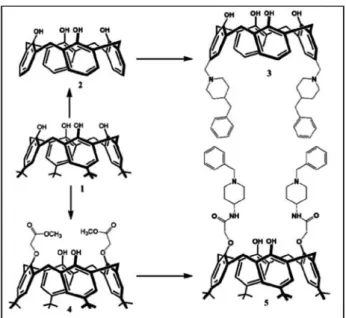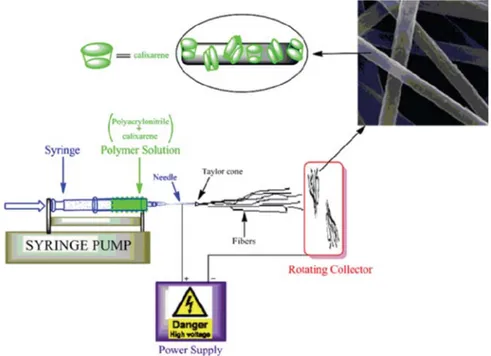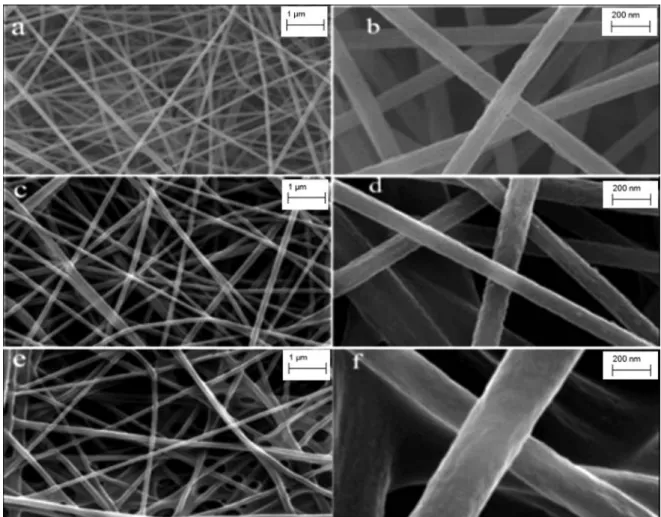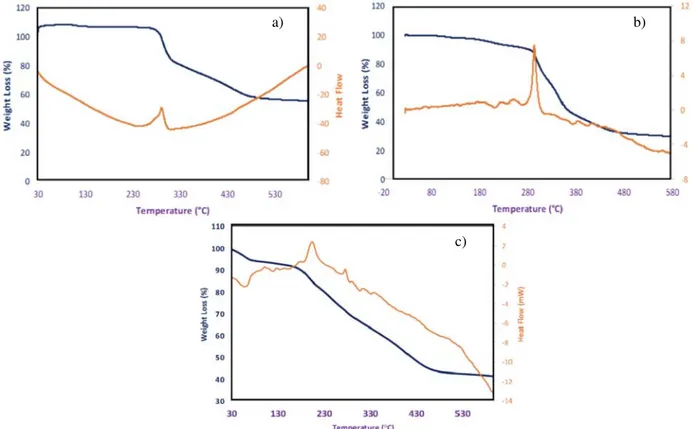Scientific paper
Electrospun Nanofibrous Polyacrylonitrile/calixarene
Mats: an Excellent Adsorbent for the Removal
of Chromate Ions from Aqueous Solutions
Mevlut Bayrakci,
1,*Fatih Ozcan,
2Bahar Yilmaz
1and Seref Ertul
2 1Department of Bioengineering, Faculty of Engineering, Karamanoglu Mehmetbey University, Karaman, Turkey2Department of Chemistry, Faculty of Science, Selcuk University, Konya, Turkey
* Corresponding author: E-mail: mevlutbayrakci@gmail.com Tel.: +90 388 2252106 fax: +90 388 2250180;
Received: 18-05-2017
Abstract
Herein, calixarene molecules containing piperidine units at lower rim or upper rim of calix skeleton was turned into a water resistant composite nanofiber adsorbent using polyacrylonitrile (PAN) polymeric support via electrospinning pro-cess. The PAN based calixarene nanofibrous adsorbents showed an excellent adsorption capacity toward the toxic chro-mate anions in aqueous solution. Furthermore, this new nanofiber mats would be promising filter chro-materials for drinking water purification.
Keywords: Calixarene, Nanofiber, Membrane, Chromate, Electrospining
1. Introduction
Chromium is a naturally occurring element and found in rocks, animals, plants, soil, and in volcanic dust and gases.1 Chromium can exist in four different oxida-tion states such as metallic chromium Cr, chromous Cr2+, chromic Cr3+and chromates Cr6+.2 In natural waters, Cr exists mainly in two different oxidation states, Cr6+ and Cr3+. Chromium (VI) and chromium (III) enter the body through inhalation, ingestion and dermal contact. The tri-valent and hexatri-valent forms are believed to be the biologi-cally active species; but, their health impacts are not iden-tical. Chromium (VI) readily penetrates biological mem-branes while chromium (III) generally does not. Cr (VI) is considered to be toxic because of its adverse effects on the health.3On the other hand, Cr (III) is virtually both less toxic than Cr (VI) and required nutrient for living orga-nisms.4The most commonly reported chronic effects of chromium (VI) exposure include contact dermatitis, skin ulcers, irritation and ulceration of the nasal mucosa and perforation of the nasal septum. Less common are reports of hepatic and renal damage and pulmonary effects (bronchitis, asthma, and bronchospasm).5Therefore, it is important to remove Chromium (VI) from polluted
wa-ters, especially those belonging to the electroplating indu-stry. In the drinking water, chromium contaminations are probably due to the industrial using of them such as mi-ning, leather tanmi-ning, dye, cement and electroplating ap-plications.6The removal of Cr(VI) from wastewater is im-portant before disposal of industrial waste into the water reservoirs such as river and lake.7For the removal of the Cr(VI) from drinking water sources, different techniques such as chemical precipitation, electrokinetic remedia-tion, membrane separaremedia-tion, bioremediation photocatalysis and adsorption are used.8Among these techniques, ad-sorption of Cr(VI) can be effective and versatile method for chromium removal particularly owing to the more eco-nomically viable, especially if low cost adsorbents are used. But in practice its advantages are largely related to the performance of the adsorbents. Compared to conven-tional adsorbents, nanomaterials have been counted as very promising candidates for high-performance adsor-bents in the most adsoradsor-bents, due to their higher surface-to-volume ratio.9 Up to now, some adsorbents, such as such as carbon nanospheres and/or nanotubes, graphene derivatives, metal oxide nanoparticles, and other nano ad-sorbents have been widely researched for Cr (VI) remo-val.9–12Considering that oxyanions are the main form of
chromate existing in water, the adsorption capacity of chromate can be expected to improve by introducing ca-tionic units onto the adsorbent surface, because of the sta-tic electrical interaction between oxyanions and positive component on the adsorbent surface.13,14Presence of the amino groups on the surface of adsorbents with various amino compounds is very effective route to prepare catio-nic adsorbents for the removing of the chromate ions. For instance, the chromate adsorption capacity of bare magne-tic Fe3O4nanoparticles from the aqueous phase was effec-tively improved after they were coated with piperidine units containing protonable amino groups at lower pH va-lues.15,16However, the large-scale treatment of magnetite nanoparticles in plants or water sources are still insuffi-cient because of the challenges such asdemagnetization, large-scale synthesis and recycling process of magnetic nano adsorbent. Recently, nanofiber adsorbents have been attracting much attention due to the both high adsorption properties and packing and durability advantages of con-ventional fiber materials.17From this point of view func-tionalized nano-fibers will be most important topic and used as affinity membranes for filtering heavy metals and toxic anions that are difficult to purify by conventional pu-rification methods. Keeping the above aspects in view, we designed and synthesized a new kind of calixarene and polyacrylonitrile (PAN) nanofiber adsorbent for chromate removal via an electrospinning technique (Figure 1 and Figure 2). Furthermore, the extraction capacity of this newly developed nanomaterial for dichromate anions was also explored and studied at different pH values by solid-phase extraction process. While PAN provides the flexibi-lity, high surface area and porosity for good chromium ad-sorption, calixarene molecules containing protonable ami-no groups as piperidine on the surface of adsorbent
sup-port the possible interaction between surface and chroma-te anions with high affinity by electrostatic attraction.
2. Experimental
2. 1. General
1H and 13C NMR spectra were obtained using a Va-rian 400 MHz spectrometer operating at 400 MHz. The prepared nanofiber mats were characterized by using a Bruker Vertex 70 ATR-FTIR instrument. Thermogravime-tric analysis (TGA) data were obtained with a Setaram SETSYS thermal analyzer. SEM images were received using a Zeiss LS-10 field emission SEM instrument. UV–Visible spectra were recorded on Shimadzu 1800 UV–Visible. Millipore Milli-Q Plus water purification system is used for the distilled water. For the pH measure-ments, An Orion 410Aþ pH meter was used. All of the reagents used in this study were obtained from analytical grade and used without further purification.
2. 2. Synthesis
p-tert-butylcalix[4]arene (1), calix[4]arene (2), 5,17-Bis-[(4-benzylpiperidine)methyl]-calix[4]arene (3), p-tert-butylcalix[4]arene diester (4) and p-tert-butylca-lix[4]arene diamide (5) compounds were synthesized ac-cording to the literature procedures.15–18
2. 3. Electrospinning
Fibers were electrospun as reported in literatu-res.17–20The polymer solution were prepared by dissol-ving calixarene compounds in DMF which is containing 15% (w/v) PAN. The concentration of calixarenes was 50 wt% with respect to the PAN concentration in DMF. The polymer solution was held in a horizontally plastic syrin-ge fitted with a metallic needle of 0.7 mm inner diameter. A stainless steel electrode was immersed in the solution and connected to a high voltage power supply. A metal plate coated with aluminum foil placed opposite served as a counter electrode. The applied voltages between the needle tip and collector were set at around 15–20 kV with a tip-to-collector distance of 15 cm. The electrospinning temperature and the relative humidity were 25 °C and 50%, respectively.
2. 4. Adsorption Experiments
The sorption capacities of the prepared nanofibers were determined by the following technique. Aqueous so-lution (10 mL) of Na2Cr2O7with 1.0 × 10-4M concentra-tion and 25 mg of the sorbent were pipetted in a stoppered flask that was shaken at 175 rpm and 25 °C for 1 h. The sorbent was separated before measurements. The residual dichromate concentration of aqueous solute was
determi-Figure 1. Synthetic route for the preparation of the lower rim or
ned by UV–Vis analyses at 346 nm. The effect of pH was studied by adjusting the pH of aqueous solutions using di-luted HCl and KOH solutions at 25 °C. The experiments were performed three times. From the blank experiments data it was observed that no dichromate extraction occur-red in the absence of the fiber mats. The percent extraction (E %) was calculated through the absorbance of the aque-ous phase measured using the following expression:
Extraction E%= (A0-A) / A0 × 100 (1) where A0and A are the initial and final concentrations of the dichromate ion before and afterthe extraction, respec-tively (Eq. 1).
3. Results and Discussion
3. 1. Synthesis and Characterization
The synthesis of desired calix[4]arene derivatives containing piperidine units at upper rim or lower rim is depicted in the Figure 1. For this purpose, the required starting materials, p-tert-butylcalix[4]arene (1), ca-lix[4]arene (2) and diester derivative (4) were synthesi-zed by following the procedure available in the literatu-re.18In case, compounds (3) and (5) were prepared ac-cording to previous reports as follow.15,16For the lower rim modified calixarene derivative, starting material (4) and 4-amino-1-benzylpiperidine were reacted in reflu-xing toluene-methanol solvent mixture. After 10 days, crude product was purified by column chromatography (SiO2, EtOAc/n-hexan; 2:1) and lower rim modified ca-lixarene based piperidine was obtained as a pale
yello-wish solid with 54% yields. As for upper rim functiona-lized calixare derivative (3), calix[4]arene (2) were inte-racted with 4-benzylpiperidine in presence of formal-dehyde and acetic acid in THF at room temperature and upper rim functionalized compound (3) was obtained as a white solid product with 53% yields after 24 hours via Mannich type reaction. After synthesis of the ca-lix[4]arene compounds containing piperidine units, pol-yacrylonitrile (PAN) nanofibers containing calixarene piperidine derivatives were electrospun from the di-methylformamide solution mixture of PAN and calixa-rene molecules (3) and (5). For the comparison study, pure PAN nanofibers without calixarene molecules were also electrospun.
Fracture morphologies of pure PAN, PAN-CLX3 and PAN-CLX4 nanofibers can be seen in Figure 3. The SEM images of nanofibers showed that there was no pha-se pha-separation in the cross pha-sectional morphology and they were comparable. In the case of PAN with and without ca-lixarene units, while the nanofibers were mostly uniform, in the fiber matrix, aggregates of calixarene crystals were also distributed. Mostly, the fiber diameters were between 285 and 330 nm for all the samples. But, compared the samples, small variations were observed. For PAN-calixa-rene systems, slightly thicker fibers were obtained when compared to pure PAN system owing to the higher solu-tion viscosity by the presence of calixarene molecules. In the case of pure PAN system, thinner fibers were observed because of the absence of calixarene molecules caused the lower viscosity of pure PAN in DMF solution. As clearly seen from SEM images, the surface morphologies of all PAN- CLX3 and PAN- CLX5 nanofibers were obviously different from the pure PAN nanofibers.
Figure 3. SEM images of prepared nanofibers: a. and b. pure PAN; c. and d. PAN-CLX5; e. and f. PAN-CLX3.
To confirm the presence of calixarene molecules on the surface of fiber webs, PAN- CLX3, PAN- CLX5and pure PAN analyzed by a surface sensitive technique, atte-nuated total reflection Fourier transform infrared (ATR-FTIR) spectroscopy. The ATR-FTIR spectra of (a) pure PAN, (b) PAN- CLX3 and (c) PAN- CLX5 nanofibers are presented in Figure 4. Typical bands include stretching vi-brations of CH and CH2groups at 2800-3000 cm-1, inten-se stretching vibration of CN at 2240 cm-1 and CH/CH
2 deformation vibrations at 1250-1500 cm-1were observed in the all FTIR spectrum.19,20On the other hand, the ab-sorption bands at around 3462 and 1667 cm-1attributable stretching vibration of phenolic hydroxyl groups and the phenyl plane bending vibration observed for PAN-CLX3 and PAN-CLX5 nanofibers were also observed, respecti-vely. These new bands confirmed that calixarene molecu-les were present on the surface of the nanofibers. In addi-tion, the absorption bands corresponding to stretching vi-bration of amide band I and amide band II for PAN-CLX3 nanofibers were observed at around 1650 and 1530 cm-1,respectively.Moreover, the frequency of the mentio-ned typical bands ascribed to the structure of calixarene skeleton was found to be unaffected by the electrospin-ning process. For this reason, no covalent bond formation between calixarene molecules and PAN was evidenced from the FTIR analysis. Therefore, incorporation of cali-xarene molecules containing piperidine units into nanofi-ber scaffold was evaluated as a process which is governed by strong physical interactions.
The thermal behaviors of the prepared nanofibers was determined by thermo gravimetric analysis in a temperature range of 25-600 °C. TG curves of (a) PAN, (b) PAN-CLX3 and (c) PAN-CLX5 were presented Figure 5. The first and rapid weight loss of PAN nanofi-bers was observed between 275 and 330 °C due to the side chain degradation of the polymer backbone. De-composition of the carbon-carbon main chains caused the weight loss was seen around 360–465 °C in TGA curves for all nanofibers. Compared with PAN nanofi-bers, it is clearly seen from the inset of Figure 5 that PAN-CLX3 and PAN-CLX5 nanofibers begin to lose weight at slightly shorter temperatures demonstrating a stabilizing effect of calixarene molecules into the poly-mer chain. The thermal decomposition behaviors of the PAN nanofibers with calixarene molecules are slightly higher than pure PAN. Furthermore, DSC curves displa-yed an exothermic for all samples and endothermic peaks only for calix nanofibers, which indicated thermal stabilizing, cyclization of nitrile group and melting pro-cess of PAN nanofibers. The exothermic peak of pure PAN displayed at 290 °C due to multiple complex che-mical reactions, such as dehydrogenation, instantaneous cyclization and crosslinking reactions associated with the oxidative stabilization of PAN.21,22In addition, the weak endothermic peaks attributable the melting of the pure calixarene compounds for PAN-CLX3 and PAN-5 during the heating stage, which are centered around 200 °C, were also observed.
Figure 5. TG and DSC curves of nanofibers (a) PAN, (b) PAN-CLX3 and (c) PAN-CLX5.
a) b)
3. 2. Chromate Extraction Studies
From the spectroscopic data, it can be seen that the obtained fibers are porous and amine modified calixarene molecules were immobilized on the surface. This distinct morphology of the resultant nanofiber mats would be very favorable to the adsorption of anionic chromate ions. The synthesis of supports and hosts for specific anions as dic-hromate is an important goal. Because Cr (VI) has well known effects on environment and living organism, it is necessarily to remove Cr (VI) from wastewater. Therefore, a series of experiments were carried out to evaluate the binding capability of nanofibers mats towards chromate ions in aqueous solution. The effect of pH on the chromate adsorption abilities of the prepared nanofibers pure PAN, PAN-CLX3 and PAN-CLX5 at room temperature was pre-sented at Figure 6. From the adsorption experiments, It was found that the chromate uptake ability of the nanofi-bers PAN-CLX3 and PAN-CLX5 reached a maximum at pH 1.5. When the pH of studied solutions gradually de-creased, the adsorption performance for PAN-CLX3 and PAN-CLX5 sharply increased. From Figure 6, it is clear that maximum extraction 90% for PAN-CLX3 and 85% for PAN-CLX5 occur in aqueous solution at pH 1.5; which shows that best interaction between fibers PAN-CLX3, PAN-CLX5 and the chromate ions occurs at this pH. On the other hand, pure PAN nanofibers have almost no ad-sorption capacity for chromate anions, whereas calixarene-modified nanofiber exhibited increased adsorption percen-tage at different pH values. The following reasons should be accountable for these findings. Firstly, the amino groups of calixarene piperidine molecules on the surface of fiber mats are prone to protonation in acid solution which en-hances the electrostatic interaction between protonated ca-lix piperidine units and anionic chromate ions as well hydrogen bonding. The next reason is that PAN nanofibers based calixarene containing piperidine units have a more stable skeleton and functionalized groups due to presence of calixarene molecules. With increasing pH values, the possible interaction between chromate ions and fiber webs
at aqueous solutions decreased and the extraction percen-tage became less for all studied nanofibers. The slight crease in anion binding efficiency of all nanofibers at in-creased pH values (from 5.5 to 8.5) may be explained by the location of the sodium cation coming from dichromate so-called ion-pairs. Cr (VI) is unstable and shows very oxi-dizing behaviors in the presence of the electron donor in acidic medium. HCrO4–is the dominant form of the chro-mium at pH 1 and 6 and only CrO4–2ions exist above pH 7. With the increase of pH, the proportion of HCrO4– decrea-sed and the content of CrO42–increased until it was the pre-dominant species at pH values over 7.5.
Apparently, the CrO42– oxyanion needs one more adsorption site than the HCrO4–oxyanion. It is understan-dable that the adsorption capacity decreased with the pH increasing from 1.5 to 8.5. Compared the published litera-ture results about dichromate extraction by solid materials as magnetite nanoparticle with piperidine units, fiber ver-sion of calixarene piperidine molecules showed excellent extraction results.15,16 These results are probably due to the special and large surface area, high porosity, micropo-resity and high flexibility properties of the fiber structures of calixarene piperidine nanofiber mats. At the lower pH values both the formation of HCr2O7-Na+and the proto-nation of the amine nitrogens of piperidine units of calixa-rene molecules favor extraction. Additionally, both the competing ion and temperature effect on chromate anion extraction of PAN-CLX3 and PAN-CLX4 was explored by using the mixture of Cl–, SO
4 2–, NO
3
–and chromate an-ions at the different temperatures such as 25, 30 and 35 °C. From the obtained results, it was clearly observed that both the presence of the competing ions such as Cl–, SO42–, NO3–and different temperature values did not have any considerably effect onto the extraction percentage of chromate ions with PAN-CLX3 and PAN-CLX4. In the light of these results, PAN-CLX3 and PAN-CLX4 bers could be used as selective ionophore based nanofi-bers for chromate anions in the presence of foreign anions at different temperatures.
Figure 6. Extraction percentages (%E) versus pH following the solid phase extraction of dichromate anions with nanofibers CLX3 and
4. Conclusion
As a summary in this study, the preparation and an-ion binding properties of PAN nanofibers based calixare-ne containing piperidicalixare-ne units with amide and/or amicalixare-ne functionality were successfully carried out. In the fabrica-tion process, PAN nanofibers based calixarene piperidine units were first produced with the aim to develop functio-nal nanofibers. Owing to the presence of calixarene pipe-ridine molecules onto the nanofiber scaffold, PAN-CLX3 and PAN-CLX5 exhibited higher affinity toward chroma-te anions. This situation is probably due to the very high surface area, porosity, flexibility and microporesity of PAN nanofibers and surface associated with calixarene molecules. Calixarenes are already being used in variety areas such as pharmaceuticals, catalyst, filtrations and controlled drug delivery systems, therefore, having nano-fiber structures might hopefully extend the use of calixa-renes in these fields or in other functional systems. Hence, a new inexpensive material is proposed via electrospin-ning as a useful membrane type adsorbent for removal of chromate anions in aqueous solution. Moreover, our fin-dings may contribute to the fabrication of new functional nanofibers from other types of calixarene and/or other su-pramolecular systems via electrospinning.
5. Acknowledgments
The authors gratefully would like to thank Karama-noglu Mehmetbey University Research Foundation (Pro-ject number 25-M-15) for financial support.
6. References
1. A. E. P. Del Real, J. M.Silvan, S. de Pascual-Teresa, A. Guer-rero, P. García-Gonzalo, M. C. Lobo, A. Pérez-Sanz,
Envi-ron. Sci. and Pol. Res. 2017, 1–11.
https://doi.org/10.1007/s11356-016-8218-4
2. J. S. Chin, A. I. Gopalan, N. Muthuchamy, K. P. Lee,
Poly-mers 2016, 8, 445.
https://doi.org/10.3390/polym8120445
3. L. C. Hsu, S. L.Wang,Y. C. Lin, M. K.Wang, P. N. Chiang, J. C.Liu,Y. M. Tzou, Enviro. sci.& tech. 2010, 44, 6202–6208. https://doi.org/10.1021/es1017015
4. M. Gheju, Water. Air Soil Pol. 2011, 222, 103–148. https://doi.org/10.1007/s11270-011-0812-y
5. T. Burks, PhD Thesis. KTH Royal Institute of Technology
2016.
6. D. K. Harijan, V. Chandra, J. Environ. Chem. Eng. 2016, 3006–3012. https://doi.org/10.1016/j.jece.2016.06.014 7. R. Bhateria, D. Jain, Sustain Water Resour. Manag. 2016, 2,
161–173. https://doi.org/10.1007/s40899-015-0014-7 8. S. Kuppusamy, T. Palanisami, M. Megharaj, K.
Venkates-warlu, R. Naidu, I Rev. Environ. Contam. and Toxic. 2016,
236, 117–192. https://doi.org/10.1039/C5RA26973C
9. Y. Ma, B. Zhang, H. Ma, M. Yu, L. Li, J. Li, RSC Adv.
2016, 6, 30739–30746.
https://doi.org/10.1007/978-3-319-20013-2
10. M. Li, C. Wang, M. J. O’Connell, C. K. Chan, Environ.
Science: Nano 2015, 2, 245–250.
https://doi.org/10.1039/C4EN00204K
11. L. Yu, Y. Ma, C. N. Ong, J. Xie, Y. Liu, Rsc. Adv. 2015, 5, 80, 64983–64990. https://doi.org/10.1039/C5RA08922K 12. L. Zhang, W. Xia, X. Liu, W. Zhang, J. Mater. Chem. A
2015, 3, 331–340. https://doi.org/10.1039/C4TA05194G
13. A. Benhamou, J. P. Basly, M. Baudu, Z. Derriche, R. Hamac-ha, J. Colloid Interface Sci. 2013, 404, 135–139.
https://doi.org/10.1016/j.jcis.2013.04.026
14. T. Wang, L. Zhang, C. Li, W. Yang, T. Song, C. Tang, J. Luo,
Environ. Sci. Tech. 2015, 49, 5654–5662.
https://doi.org/10.1021/es5061275
15. S. Sayin, M. Yilmaz, M. Tavasli, Tetrahedron 2011, 67, 3743–3753. https://doi.org/10.1016/j.tet.2011.03.012 16. S. Sayin, F. Ozcan, M. Yilmaz, A. Tor, S. Memon, Y.
Cenge-loglu, CLEAN–Soil. Air. Wat. 2010, 38, 639–648. https://doi.org/10.1002/clen.201000039
17. F. Ozcan, M. Bayrakcı, S. Ertul, J. Incl Phenom. Macrocycl.
Chem. 2016, 85, 49–58.
https://doi.org/10.1007/s10847-016-0604-5
18. C. D. Gutsche, K. C. Nam, J. Am. Chem. Soc. 1988, 110, 6153–6162. https://doi.org/10.1021/ja00226a034
19. Y. Liu, G. Jiang, L. Li, H. Chen, Q. Huang, T. Jiang, X. Du, W. Chen, J. Mater. Sci. 2015, 50, 8120–8127.
https://doi.org/10.1007/s10853-015-9385-2
20. H. Chen, G. Jiang, W. Yu, D. Liu, Y. Liu, L. Li, Q. Huang, Z. Tong, W. Chen, Powder Technol. 2016, 298, 1–8.
https://doi.org/10.1016/j.powtec.2016.05.017
21. L. Ji, Z. Lin, M. Alcoutlabi, O. Toprakci, Y. Yao, G. Xu, X. Zhang, Rsc. Adv. 2012, 2, 192–198.
https://doi.org/10.1039/C1RA00676B
22. M. Bayrakcı, F. Ozcan, S. Ertul, Tetrahedron 2015, 71, 3404–3410. https://doi.org/10.1016/j.tet.2015.03.090
Povzetek
Molekule kaliksarena s piperidinskimi enotami v zgornjem ali spodnjem obro~u skeleta smo uporabili za pripravo vo-doodpornega komposita nanovlaken. V procesu electropredenja smo uporabili polimeren nosilec poliakrilnitril (PAN). Tako pripravljen adsorbent na osnovi PAN kaliksaren nanovlaken je pokazal odli~no adsorpcijsko kapaciteto napram toksi~nim anionom kroma (VI) v vodnih raztopinah. Nova nanovlakna predstavljajo obetajo~ material za pripravo fil-trov za ~i{~enje pitne vode.




